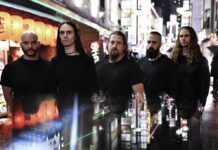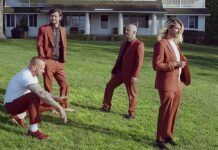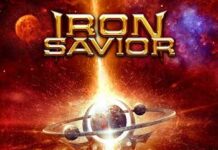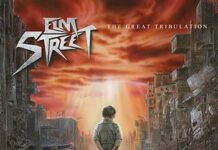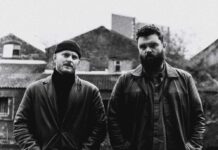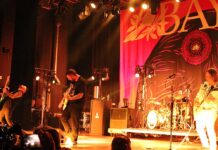
INTERVIEW WITH ROBIN STAPS BY NATHAN KATSIAFICAS
PHOTOGRAPHS BY ANDREW FAULK
We spoke with Robin Staps, founder and guitarist of progressive metal titans The Ocean (also known as The Ocean Collective), to learn how he and the band are doing now that they’ve released their latest record, Phanerozoic II: Mesozoic | Cenozoic. The record is the second half of a two-part album that thematically explores the Phanerozoic Eon, a time of tumultuous explosions of life and mass extinctions, of the formation of super continents, and the shattering of the landmasses into their current state. Staps shared the writing process behind the record, the band’s plans amidst the pandemic and for next year, the inner workings of the record label he founded, Pelagic Records, and more.
How does it feel to have the new record and bookend to the two-album Phanerozoic project, Phanerozoic II: Mesozoic | Cenozoic, finally out and in listeners’ hands?
It feels very good, it’s a bit like giving birth, you know, getting a record done and finally released that you’ve spent so much time working on. When all the bullshit started happening at the beginning of the year, we discussed whether or not we should go through with the plan to release it in September or October. By that time it was likely already that we wouldn’t be able to tour around it, but we decided to do it in the end. When you have something ready, you just want it out there already, rather than rotting on a hard drive and collecting dust. Also, we felt that it’s a good time to release music now. Although we can’t tour with it, people’s attention spans are maybe a little longer than usual since they’re sitting bored at home and are hungry for music. And I think the reaction to the album shows there was great anticipation for it. It’s definitely a big relief that it’s out now, and I can’t wait to start working on playing the record live. We’re going to start rehearsing in early November and we actually have a gig in Germany—a festival show that is going to happen with restrictions given. It’s going to be a seated show but in a pretty big venue in November, so we will eventually get to play the new material live and are really looking forward to that.
“WHEN YOU HAVE SOMETHING READY, YOU JUST WANT IT OUT THERE ALREADY, RATHER THAN ROTTING ON A HARD DRIVE AND COLLECTING DUST.”
Given the current political and public health situations, what was it like getting ready to drop the culmination of so many years of effort during a pandemic? Are you satisfied with how it has been received?
Absolutely, I mean, it’s been a huge chunk of work as you mentioned. Most of the songwriting happened in 2016 and 2017, then in early 2018 we started recording drums for the record. We actually recorded both albums in one session in Iceland in February 2018. By that time, everything was finished writing-wise, so it’s been a long time in the making—four years between starting to write for the records and the release of Phanerozoic II. It was a long stretch and now it’s finally done. This chapter is coming to an end—we’ve arrived at the present time now.
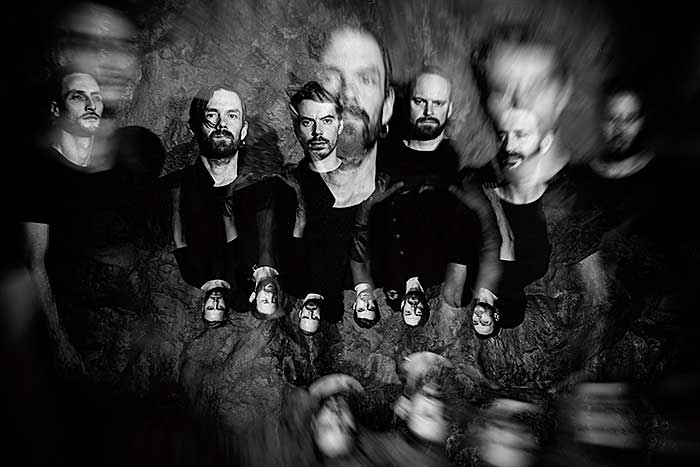
What had you been planning to do this fall before the pandemic hit and ruined things?
The plan was to tour South America in May. That was the first thing that got canceled because of Corona. Then we had a bunch of summer festivals scheduled, and then we were going to release the record at the end of September and do a big European headlining tour in early October. We have pursued that tour anyways, but pushed the itinerary into January, but now very likely it will be pushed into June of next year. It is happening with the same bands, Hypno5e, pg.lost, and Svalbard, and we now have that June backup routing in place if it doesn’t go down in January. If COVID had not happened, we would’ve been on tour now, and to be quite honest, I was actually quite happy to have the extra time this year.
“ALTHOUGH IT WAS VERY FRUSTRATING TO HAVE A LOT OF STUFF CANCELED, IT LEFT TIME FOR OTHER THINGS THAT WE OTHERWISE WOULDN’T HAVE EVER DONE.”
We were not idle. Although it was very frustrating to have a lot of stuff canceled, it left time for other things that we otherwise wouldn’t have ever done. For example, this photo book that we released with the limited vinyl editions, it’s like 130 pages of photos taken on tour in 2019 on the first half of the Phanerozoic album cycle. We had all this awesome material taken by photographers from all over the world when we toured places like Russia, Kazakhstan, Armenia, Australia, India, and New Zealand. We had this bulk of material, but laying it out and getting it touched up and made presentable was a huge amount of work that we weren’t originally going to do. Also, with my record label [Pelagic Records], we’re releasing the vinyl editions of the new Ocean album but also lots of other bands. Packaging was really challenging because it’s a super complicated tri-fold with dye-cuts and special paper. All of that took a lot of time figuring out, doing tests to get it right. We simply wouldn’t have been able to deliver it the way we’d wanted and to do so on time without the delay. The downtime also was good for us because Loïc [Rossetti, vocalist] had a problem with his ear and had to get some surgery and would’ve been out for the summer. Our bass player also had a disease in his fingers and couldn’t play for almost three months. So, it happened all at the right time. We’re just looking ahead to when things will move forward again.
You guys had a lot of cool packages with the double album, including some with trilobites, ammonites, and other fossils, interesting color variants for the vinyl, and more. How do you come up with the ideas for these? And where did you source all that?
That was quite a challenge to be honest, and I really have to credit my father for the idea with the fossils. I told him about the next concept that I had in mind for these albums, and he said, “This is awesome, you should throw in some fossils!” because there was actually a fossil lying around when we were talking about it. And at first I laughed, but then I was thinking this would actually be really cool. So, I started doing some research and trying to figure out where to get fossils in large quantities, which as you are probably aware isn’t easy. I mean, these things are being found out there. It’s not like they’re being made, and at the same time we needed something that had some sort of consistency.
“IT WAS A COMPLETELY RIDICULOUS PROJECT LOGISTICALLY, BUT SUPER FUN AS WELL AND PEOPLE LOVED IT.”
We had 1,000 box sets to produce, and 250 of them came with three fossils, one from the Paleozoic, one from the Mesozoic, and one from the Cenozoic—that was 250 x 3 already! And then the remaining 750 orders came with one each. So, we had to gather 1,500 fossils yet have some sort of consistency of weight and size at the same time just to make it feasible logistically, like to pack them and fit them into the box sets. You can’t ship a huge trilobite that weighs like 3 kg, it all had to be very consistent. Since these things are being found out in the wild, it was quite a challenge, but we had help from a really nice lady at the geologic institute in Munich. She was very into the project and helped us source them from trade fairs, from commercial resellers, but it was still a challenge. The limited green box sets were the hardest, finding 250 of each of the trilobite from the Paleozoic, the ammonite Cleoniceras from the Mesozoic, and this petrified fish skeleton, Knightia eoceana, from the Cenozoic. That last one was the most difficult to find—from the youngest time, ironically. For the remaining 750, we sold what we got, like Mosasaur teeth for 70–80 of the other box sets for example and then would change it to another type of fossil. It was a completely ridiculous project logistically, but super fun as well and people loved it. It’s something no one has really done before.

This two-album effort continues the geologic themes found in many of The Ocean’s songs and album titles, much like 2007’s Precambrian. What is it about deep time/geologic time that you find fascinating? Mass extinctions are pretty “metal”…
Exactly! There you go, that’s exactly how I ended up with the idea to bring that into our music. It was by visualizing or trying to imagine adequate, fitting scenes for the music I was writing at the time of Precambrian. And I always have these prehistoric landscapes in front of my inner-eye—streams of lava, outbreaking volcanoes, and things like that. That was maybe because I was studying geography at the time, but also just because it seemed to be a really fitting representation of this kind of primal, primordial archaic music that I was writing at the time. That’s how I initially found access to it, but I was always just interested in geography. I studied it, so at one point it just made sense to combine my two interests there and bring it all together. That started with Precambrian, and then we focused on something completely different with the –centric records [Heliocentric and Anthropocentric] in 2010. It was more like a philosophical/religious type of theme that we explored there, about the legacy of Christianity.
“I ALWAYS HAVE THESE PREHISTORIC LANDSCAPES IN FRONT OF MY INNER-EYE—STREAMS OF LAVA, OUTBREAKING VOLCANOES, AND THINGS LIKE THAT.”
And then after that, when I was starting to write what became the Phanerozoic records. I began to realize it reminded me of the second half of Precambrian, just like musically. I felt that vibe, especially the songs that ended up on Phanerozoic I. And then I was thinking that there was this gap, this void between the end of Precambrian and the -centric records, which start with the beginning of humanity. And that void conceptually was the Phanerozoic Eon [in geologic time] and musically there was also this gap between Precambrian and Heliocentric. Precambrian was this really important record for us, but it was recorded with a totally different lineup and the -centric records were recorded with Loïc on vocals and they were the first ones. So, we also wanted to make a record that bridges this gap musically. That’s what Phanerozoic essentially became, like a bridge record. I realize that 10 years after the release of Precambrian, it makes sense to go back there and connect with that, but at the same time connect it with the present tense of the band and the lineup where we currently stand. That was the mindset when we were writing.
Lyrically, some of these songs, like “Permian, The Great Dying,” link to an extinction that happened ~250 million years ago because of greenhouse gases, but also link to our present, where we’re doing the same thing to our environment, just much faster…
Exactly! And obviously not all the songs are directly dealing with what happened during the respective geological eras. Some of them are making direct reference to that, but it would also get a bit boring to just talk about a time on Earth when there was no human life. So, there is this meta-thread that is also going through both records discussing the idea of eternal recurrence, which is the idea that things just happen over and over again in infinite time and space. And if you look at the Phanerozoic and what happened—all of the extinction events for example—you find lots of hints or like examples for that idea, that things have just happened multiple times. We’ve had five large mass extinction events during that eon, continents have collided and drifted apart and collided again, and we’ve had all different kinds of forms of life flare up in different parts of the globe, then go extinct and come back. You see lots of examples for that theory, and this is what is woven into the geological fabric as well. So, it’s not just only talking about these big inanimate eras where there was no human life. There is always this meta-level that is hidden in the fabric of those songs.
What is the writing process for massive tracks, like this album’s “Jurassic | Cretaceous”? That song is huge in length and dynamics. How do you go about writing as a band, or was this all your own effort?
That song was all me, basically. All the songs on the Mesozoic half are songs that I wrote. For me, writing is quite an intimate process. We don’t jam out tunes in the rehearsal space, I just work them out at home with my guitar and program drums, synths, and the basic elements. That song, in particular, was a bitch to write—one of those tracks that never got finished somehow. I think I’ve been working on that slowly over the course of two years, like not constantly obviously, but it was always in need of something. I always liked it, but it never got to the point where it felt finished, like I’ve rearranged that song so many times. It was really like one of the longest songs in the making. I’m really happy that it eventually did get finished because sometimes these songs become hard drive corpses. You’re not 100 percent happy with them, so at one point you just focus on new things and then they never get finished, but this one eventually did. And this was really written sitting at home, trying out things until I had it right. Some songs are like that. Other songs are written really quickly. “Pleistocene” was written in a day, or tracks like “Paleocene.” So, it’s really different.
“THE INITIAL WRITING PROCESS IS REALLY SOMETHING THAT HAPPENS AT HOME AND NOT IN THE REHEARSAL SPACE FOR US.”
This is also the first record where I’m not the only songwriter. Paul [Seidel, drummer] has written three tracks, “Oligocene,” “Holocene,” and “Miocene | Pliocene.” He writes similarly to how I do. He did these tracks on his own, played them to us, and then I started working on guitars and he started adding other details, which always happens. But yeah, the initial writing process is really something that happens at home and not in the rehearsal space for us. We work out pretty detailed pre-production tracks and then get into the room when everybody already has an idea of his parts and the basic structure of the song. And then we start testing transitions and working out details.
On this record, the other guys have been a lot more involved on all their respective instruments. I used to write the bass lines for example, but on this record, Mattias [Hägerstrand] wrote his own. Peter [Voigtmann’s] contribution on synths is more substantial than previously—I mean, Phanerozoic I was the first record he played on. He really glued everything together because the material is very diverse, and for quite some time I didn’t really see how this could really become one record. But Peter glued it all together, and once we heard all these tracks in a homogenous sound, with the same type of drum sound and heavy guitar sound, then it started making sense. And only then did we really decide on a final song order. The Mesozoic half was decided on from the beginning, but the Cenozoic half was an open book that we didn’t know what to do with. It was cool in a way, because it was a bit of a different approach. All of our previous records, everything was perfectly laid out from the beginning. Here, we let a little more space for things to just happen, to fall into place fairly late in the process. I think that worked out really well in this record.
It sounds more free-form and less linear, but still takes you on that journey…
Yes, it does, it does! And that’s something really awesome, because we didn’t set everything in stone at an early stage, but rather kept developing the songs and waited until almost the last moment to put everything together. It was a new experience for us to do a record that way. Pelagial was written from the beginning to the very end in a very linear way—that had to happen that way also because I wanted that record to become that journey, that gradual progression that goes heavier and slower and lower in tuning and more claustrophobic as you’re going from the surface of the sea to the bottom. But somehow strangely, a similar thing happened with Phanerozoic II and this was not intentional. The process of getting there was very different. It was very isolated tracks that we pieced together at the very end, but it still became the journey somehow. I think that’s a nice reward for being willing to let things happen and leave more creative space to the other people in the band. I’m glad that I opened myself up for that because I have this great bunch of people and musicians around me and I trust them very much. It’s really cool to see them getting more involved in the creative side of things as well. I think it really benefited this record.
“WE DIDN’T SET EVERYTHING IN STONE AT AN EARLY STAGE, BUT RATHER KEPT DEVELOPING THE SONGS AND WAITED UNTIL ALMOST THE LAST MOMENT TO PUT EVERYTHING TOGETHER.”
The Ocean has now covered geologic time fully, as well as atheism and Christianity, and science and how that all interplays. With Pelagial you explored the ocean and marine life and how all that is related. What’s next for The Ocean, something cosmic? A non-concept album? Have you started to think about that yet?
(laughs) Not really. To be honest, I was really focused on finishing this record for the last couple of months and I am also that type of person that needs to put all of his energy into one project and then once that is done, it’s time for something new. So, I haven’t really started picking my brain about where to go next. It might be a total anticlimactic story where we do something that is much less conceptual than on our previous records, because we haven’t done that for quite some time now. Maybe it’s going to be a simple straightforward heavy rock album, but I honestly don’t know now.
There are definitely a lot of other exciting things to be explored. We will get there, we will think about that when we get there, but right now the focus is relearning the material because we haven’t rehearsed the Phanerozoic II songs since early 2018. We have to all relearn the songs and make them fit for being played live. Maybe we’ll do a live stream—we’re talking about that right now—and then eventually go out on tour next year and tour the fuck out of this record! That’s gonna keep us busy for the next year and a half. I don’t write on tour or even at home. I really have to decide on a timeframe of two or three weeks for that and take myself away, out of my place, out of Berlin, and put myself in isolation to be able to write. It’s not a daily thing for me, it’s something where I have to get into the zone and then it happens quite quickly and efficiently, but I don’t see a big writing session happening anytime soon because we’re so focused on this record.
For fans who might not realize it, you founded your label, Pelagic Records, which has now had more than 150 physical releases in the past 11 years, including releases from massive bands like Cult of Luna, God Is An Astronaut, and of course, your own band. How have your experiences with The Ocean colored the way you run your label? How is Pelagic doing given the current circumstances with COVID-19?
Pelagic is doing very well—much better than we initially feared. Of course, the whole distribution side of things almost collapsed in March or April, especially in the US. That was a significant loss of income compared to normal months, but on the other hand we’ve seen a steep increase in orders. Like I said, people are sitting bored at home and are hungry for music, so we’ve had a lot more orders this year than in any previous year. We’ve also done more releases because I wasn’t on tour with The Ocean, so there was extra time to focus on the label. We’ve also done some other projects like Pelagic Coffee, which we started and was something I’ve wanted to do for a while.
So, Pelagic is doing very well, we have a team of five-ish people, four full-time employees and Paul [Seidel], who is a freelancer for us. We also just took over the webstore of Kadavar, a pretty big Berlin 70s rock band, which brought a lot of new people into our audience. We’ve been super busy with lots of exciting projects at Pelagic, and it’s growing at a very fast pace and that’s just great to see. To answer the first part of your question, Pelagic Records wouldn’t exist without The Ocean. The reason I started the label was because I wanted to re-release an old Ocean record that Metal Blade didn’t want to do at that time. They told me, “Why don’t you do it yourself?” And they gave me a couple distribution contacts and that’s how I re-released Fluxion—that was the first Pelagic release. I enjoyed that and released a small Swiss band that I was really into called Nebra that was a total financial failure, but still a great record that I have no regrets about having touched. The third record was God Is An Astronaut’s All Is Violent, All Is Bright. That sold well, and by that point I really enjoyed the label side of things.
I’ve always been the guy that doesn’t just enjoy music from the perspective of playing the guitar on stage. Obviously, that is super fun, but it’s only part of the big picture for me. I also enjoy the management side and the strategic side of developing things together for my own band but also for other bands that I am into. It’s something I just genuinely love, and that’s why Pelagic picked up speed over the years and turned from this basement operation that was more like a hobby into a label that is more than a full-time job for like five or six people involved. I’m very happy about that, too, because there are so many different angles of looking at music. On stage playing is definitely one of them—probably the most important one—but there are also all these other interesting angles. I enjoy networking and going to festivals and building up bands without being on stage myself. I’m very thankful that I have these two realms that are overlapping and sometimes conflicting.
When I am on tour with The Ocean, there’s not enough time to do Pelagic things. Even though you might think that on a bus tour you might have all this time to kill, it’s not like that because the day is just divided between certain routines. Get in, catering, sound check, doors, and then press—you always have just an hour here, a half an hour there. It’s difficult to get anything done. On the last tour we did in Europe with Leprous, Paul and I realized it’s just fucking challenging to get all the Pelagic work done while being on tour. Now that we’ve hired all these new people this year, we will be able to have this operation running while we are away. We can make sure that this actually works. I don’t have to be afraid to rely on the people back home to keep things going.
“I GOT REALLY ANGRY, BUT NOW I’M JUST AT PEACE THAT IT’S THE STATE OF THE WORLD, EVERYONE IS IN THE EXACT SAME SITUATION, WE JUST HAVE TO WAIT IT OUT.”
What hopes do you have for the future of The Ocean in the coming year?
We can’t wait, we’re itching to get back on stage. It’s only a matter of time. Initially, I was really frustrated. We spent so much time working on that South America tour and then it all fell through and turned to shit. So, I got really angry, but now I’m just at peace that it’s the state of the world, everyone is in the exact same situation, we just have to wait it out. Hopefully, some time during the spring of next year it will be possible to play shows like normal again. For now, until then, we will do these sort of weird, experimental shows, like I said we have one in November that is a seated show with social distancing. I think it’s probably going to be a weird experience, but probably a memorable one later, because there’s nothing else right now. I think people are so hungry for live music that it could go really well. Obviously, there will be a lack of contact that is very vital and integral to the live experience, but we’ll see how that goes. I think it’s going to be interesting. We may do a couple more of these shows in January in Germany should the tour as a whole get canceled, which I sort of assume will happen. It will be good to test the waters, hang out with the boys, and bridge this terrible time until we can return back to normal again.






